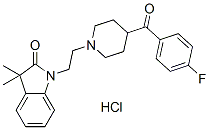|
受注:045-509-1970 |
技術サポート:[email protected] 平日9:00〜18:00 1営業日以内にご連絡を差し上げます |
化学情報

|
Synonyms | N/A | Storage (From the date of receipt) |
3 years -20°C powder 1 years -80°C in solvent |
| 化学式 | C24H27FN2O2.HCl |
|||
| 分子量 | 430.94 | CAS No. | 192927-92-7 | |
| Solubility (25°C)* | 体外 | 4-Methylpyridine | 24 mg/mL warmed with 50ºC water bath (55.69 mM) | |
| DMSO | 0.4 mg/mL (0.92 mM) | |||
| Water | Insoluble | |||
|
* <1 mg/ml means slightly soluble or insoluble. * Please note that Selleck tests the solubility of all compounds in-house, and the actual solubility may differ slightly from published values. This is normal and is due to slight batch-to-batch variations. |
||||
溶剤液(一定の濃度)を調合する
生物活性
| 製品説明 | LY310762 is a 5-HT1D receptor antagonist with Ki of 249 nM, having a weaker affinity for 5-HT1B receptor. |
|---|---|
| in vitro | LY310762 has a higher affinity for the guinea pig 5-HT1D receptor than for the 5-HT1B receptor. LY310762 potentiates the potassium-induced [3H]5-HT outflow from guinea pig cortical slices with an EC50 of 30 nM. The maximum potentiation of the potassium-induced outflow which is obtained with LY310762 is about 40%. [1] LY310762 blocks the decreased EPSC amplitude induced by Sumatriptan. [2] |
| in vivo | Systemic administration of LY310762 (10 mg/kg i.p.) produces a further significant enhancement in the 5-HT response to fluoxetine (20 mg/kg i.p.) when compared to animals receiving a control vehicle injection. In fluoxetine treated animals, levels of 5-HT increases from 312±43% to a maximum of 683% after LY310762. In control animals, levels of 5-HT remains unchanged (250%). LY310762 administered alone also significantly increases basal levels of 5-HT above vehicle controls, reaching a maximum of 258% compared to the pre-injection control. [1] |
プロトコル(参考用のみ)
| キナーゼアッセイ | [3H]-5-HT outflow from guinea pig cortical slices | |
|---|---|---|
| Male Dunkin Hartley Guinea Pigs (350-400 g) are killed by asphyxiation with CO2 and their brains rapidly removed. Cortical slices (350 × 350 μm) are prepared, washed once in basal buffer (10 mM HEPES, 133 mM NaCl, 4.8 mM KCl, 1.2 mM KH2PO4, 1.2 mM MgSO4, 1.5 mM CaCl2, 11.1 mM glucose, 10 μM pargyline pH 7.4) and incubated in basal buffer at 25 mg/mL wet weight with [3H]5-HT (50 nM) for 30 minutes at 37 °C. The slices are washed three times in basal buffer and transferred to baskets (10 mm i.d. polypropylene tubes with 150 μm nylon mesh bases) at approximately 5 mg wet weight per basket. The baskets are used to transfer the tissue between the washing and release buffers. In order to obtain stable baseline release, the slices are incubated for 11 minutes in basal buffer (0.5 mL), transferred for 4 minutes to a second tube containing basal buffer (0.5 mL) and then, for a further 4 minutes, to basal buffer (0.5 mL) or to a buffer in which NaCl has been substituted with KCl, on an equimolar basis, to give a KCl concentration of 30 mM (release sample). All buffers used in the 11 minutes and the two 4 minutes incubations contained 1 μM paroxetine. Following the incubations, the tissue is digested with Soluene-350 (0.7 mL) and the baskets rinsed with propan-2-ol (0.7 mL). The tritium label in the tissue samples and in the buffers from the three incubation periods is estimated by liquid scintillation spectroscopy. LY310762 being tested is present throughout the three incubation periods and is tested in six replicates. The basal release is measured in four replicates and the control release in eight replicates. The tritium label in the release sample is expressed as the percentage of the total tritium in the tissue at the time the sample is collected (% fractional release). Stimulated release is calculated as the % fractional release produced by the high potassium buffer minus that of basal release. The percentage increase in release produced by LY310762 is calculated as the increase over the control stimulated release, where the control release is 100%. For individual experiments the mean of the replicate data is calculated. The results are the means and standard errors of at least three separate experiments. | ||
| 動物実験 | 動物モデル | Dunkin Hartley guinea pigs weighting 350-400 g |
| 投薬量 | 10 mg/kg | |
| 投与方法 | Administered via i.p. | |
参考
|
長期の保管のために-20°Cの下で製品を保ってください。
人間や獣医の診断であるか治療的な使用のためにでない。
各々の製品のための特定の保管と取扱い情報は、製品データシートの上で示されます。大部分のSelleck製品は、推薦された状況の下で安定です。製品は、推薦された保管温度と異なる温度で、時々出荷されます。長期の保管のために必要とされてそれと異なる温度で、多くの製品は、短期もので安定です。品質を維持するが、夜通しの積荷のために最も経済的な貯蔵状況を用いてあなたの送料を保存する状況の下に、製品が出荷されることを、我々は確実とします。製品の受領と同時に、製品データシートの上で貯蔵推薦に従ってください。
